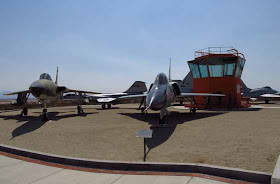 |
| Planes parked outside the check-in building |
I was a little disheartened when I received confirmation of
our scheduled tour date, as the invitation stipulated that no cell phones or
cameras would be allowed on Edwards Air Force Base. Here I was, planning a weekend away around this tour, and I wouldn't be able to take any photographs! Nonetheless, this was a place where history
was made, and where important work was still being carried out. It was a place I had wanted to visit since reading Tom Wolfe's book The Right Stuff. So I ignored my
first impulse to cancel the trip, and continued to plan a weekend trip around
our tour of the base.
As we checked in that morning, I was surprised by how many people spoke languages other than English, and presented different colored
passports (instead of drivers licenses) for their identification.
Clearly, many visitors had come from farther away than San Diego to tour
the base. We walked around, studying some of the planes
that sat outside the welcome center while the staff finished checking everyone
in. Then our tour guide, Don, called us
over to the bus. After we climbed aboard, the engine rumbled into life, and
the bus rolled past the guard shack.
Planes sat outside the museum, and our time there was
unstructured, allowing us to inspect the planes, or wander inside to watch a
video, peruse the displays, and see the other aircraft inside. There weren’t many of the latter, but Chuck
Yeager’s familiar orange Bell X-1 hung from the ceiling, and its rocket engine sat on the floor with its housing removed so we could
see all its component parts. More
engines and plane components were on display, as well as flight suits and
uniforms from notable test pilots such as Yeager. The video showed important moments from the
past, and discussed how the base had evolved. Models of all the experimental planes that had
been tested there filled one wall. Then
we wandered outside to inspect the planes.
As the weather was pleasant, I hadn’t brought a cap with me. I had brought a rolled up knitted hat in case my head got cold, after all. I soon discovered this was a mistake. The
sky was so clear, and the sunlight so bright, that even with my sunglasses on,
I started to get a headache. I held a hand over my eyes as I squinted at some very cool
planes, including a SR71 Blackbird, and a B52 Stratofortress. Someone had thoughtfully set up a concrete
picnic table beneath the B52’s wing, but lunchtime was hours away, so after
inspecting all the planes (and a few helicopters), we headed back inside.
 |
| After the tour, when we got the camera, and (more importantly) my hat, out of the car. |
 |
| Can you see how I'm looking down? Even with my cap and sunglasses, I'm squinting. |
 |
| Salt: Ooh, it's so bright, I can't see! Pepper: Switch optical sensors to maximum polarization. |
Shortly thereafter, Don began his talk, and we all took to
the chairs as he told us about the base.
Rogers Dry Lake bed was the perfect place for Flight Test, as the area
was remote, and the ground was relatively flat for such a large area. Approximately half of the forty-four square
miles are used as runways. Larger
aircraft like a B52, or (in past years) the Space Shuttle, are heavier, and
land on one of the paved runways. But
the clay suffices for most of the lighter aircraft, so the Air Force merely
paints a long, straight line of paint, and adds a few lights, to create
additional runways. With an average of
350 days of bright, clear skies each year, and all that hard, flat clay to land
on (whether a plane lands as scheduled, or performs an emergency landing on
unmarked ground), it’s the perfect location for testing experimental aircraft
designs and equipment.
More tomorrow.
Dragon Dave

No comments:
Post a Comment